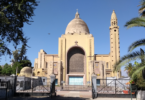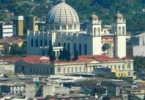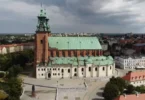
Introduction
St. Matthias’ Abbey is a Benedictine monastery in Trier, Rhineland-Palatinate, Germany. The abbey church, a Romanesque basilica, is a renowned place of pilgrimage because of the tomb of Saint Matthias the Apostle, after whom the abbey is named, located here since the 12th century, and the only burial of an apostle in Germany and north of the Alps. The abbey was originally named after Saint Eucharius, first Bishop of Trier, whose tomb is in the crypt. The church has been given the status of a minor basilica.
Magnificent St Matthias Abbey is thought to be Germany’s oldest Christian church. Begun in 1127, when the relics of the Apostle Matthias (Judas’ successor) were found here, it was added to over the ensuing centuries. Treasures include the Holy Cross Chapel’s Staurotheke (1240), containing a piece of Christ’s cross. Steps on either side of the Romanesque–Gothic interior lead to the crypt, home to the sarcophagi of the abbey’s first two bishops, Eucharius and Valerius, and St Matthias’ relics.
St. Matthias Abbey, founded in the 4th century, is a Benedictine monastery with a Romanesque basilica as its abbey church. Since the 12th century, the tomb of Apostle Matthias, the only apostle’s tomb on German soil and north of the Alps, has been venerated in the crypt of the basilica. When French army troops entered Germany after the Revolution, they requisitioned the abbey buildings in 1794. The abbey was dissolved in 1802 and it was not until 1922 that monks returned to the abbey. Below the choir, the visitor can visit the impressive crypt, where numerous sarcophagi (including the two sarcophagi of the first bishops of Trier, Valerius and Eucharius) are kept. The eastern part of the crypt was added around 1500.
Saint Matthias’ Abbey is a Benedictine monastery in Trier. The abbey church, a Romanesque basilica, is a renowned place of pilgrimage because of the tomb of Saint Matthias the Apostle, after whom the abbey is named, located here since the 12th century, and the only burial of an apostle in Germany and north of the Alps. The abbey was originally named after Saint Eucharius, first Bishop of Trier, whose tomb is in the crypt. The church has been given the status of a basilica minor.
Monks have lived in the present Saint Matthias’ Abbey since late antiquity. The monastery adopted the Rule of Saint Benedict in about 977. Saint Matthias’ Basilica, which was dedicated on 13 January 1148, combines four functions. It is the parish church of the parish of the same name; the monastic church of the Benedictine community; a pilgrimage church centred on the tomb of Saint Matthias the Apostle; and the burial church of the first bishops of Trier, Eucharius und Valerius.
Magnificent St Matthias Abbey is thought to be Germany’s oldest Christian church. Begun in 1127, when the relics of the Apostle Matthias were found here, it was added to over the following centuries. According to tradition, Matthias preached in Cappadocia, Turkey, and was martyred at Colchis, on the eastern coast of the Black Sea. He was sentenced to stoning but this method miraculously failed, so he was beheaded. St. Helena, Constantine’s mother, is said to have brought St. Matthias’ relics from Jerusalem and divided them between the Basilica of St. Mary Major in Rome and this abbey church at Trier.
The building retained its role as an abbey church and burial church of St. Eucharius and St. Valerius. The architecture of the abbey is eclectic, the western facade features a mix of baroque, Romanesque and classicist forms. When French army troops entered Germany after the Revolution, they requisitioned the abbey buildings in 1794. The abbey was dissolved in 1802 and it was not until 1922 that monks returned to the abbey.
Acts 1:26 reports that Matthias was chosen to replace Judas because he was a witness to the Resurrection. According to early Christian writers (Clement of Alexandria, Jerome, Eusebius, and others), Matthias was one of the 72 disciples Jesus sent out during his ministry. He is said to have lived an ascetic life in order to make his spirit subject to the Crucified One. According to tradition, Matthias preached in Cappadocia, Turkey, and was martyred at Colchis, on the eastern coast of the Black Sea. He was sentenced to stoning but this method miraculously failed, so he was beheaded.
St. Helena, Constantine’s mother, is said to have brought St. Matthias’ relics from Jerusalem and divided them between the Basilica of St. Mary Major in Rome and this abbey church at Trier. In Trier, the monks enshrined the relics in a beautifully carved tomb before the altar. Records dating back to the 5th century indicate the existence of a monastery here, on the graves of the first Christian evangelists sent to Trier. Both monastery and church were rebuilt after the disaster of Maundy Thursday, 882, when the Normans conquered and destroyed Trier. Most of the abbey church that stands today dates from the Romanesque period (1127-1160). The church was consecrated in 1148 by Pope Eugene III.
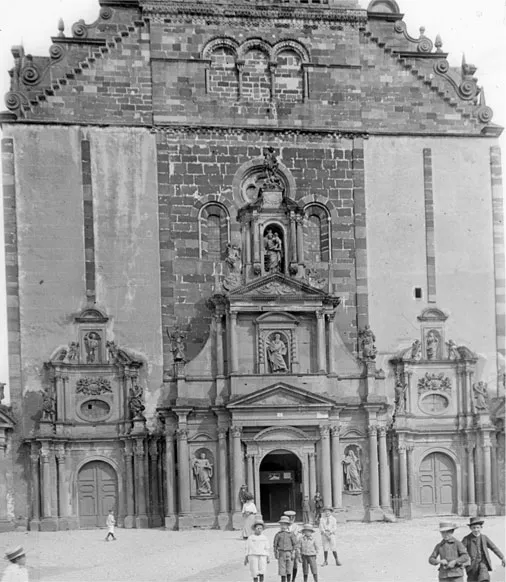
Monks have lived in the present St. Matthias’ Abbey since late antiquity. Cyrillus of Trier built an oratory here in the second half of the 5th century and gave the monks a rule. The monastery adopted the Rule of Saint Benedict in about 977. Since the 10th century the bones of the founders of the Archbishopric of Trier, bishops Eucharius and Valerius, have been preserved here. The bones of the Apostle Matthias were supposedly sent to Trier on the authority of the Empress Helena, mother of the Roman emperor Constantine I, but the relics were only discovered in 1127 during demolition work on the predecessor of the present church buildings, since which time the abbey has been a major centre of pilgrimage.
In the 12th century, the manuscript now known as Kues 52, an important witness to the Collectaneum of Sedulius Scottus and the Proverbia Grecorum, was copied at St. Matthias’. Efforts to reform in the wake of the Council of Basel, under Johannes Rode, the Carthusian prior appointed by the bishop, led to spiritual and economic renewal, to the extent that St. Matthias’ became an example for other monasteries. In 1433, at the request of Duke Otto of Brunswick, John Dederoth, having effected notable reforms at Clus Abbey, turned his attention to the extremely neglected and dilapidated Bursfelde Abbey. He was able to obtain two exemplary monks from St. Matthias’ Abbey to maintain his reformed discipline there. In 1458 St. Matthias’ joined the Bursfelde Congregation.
The eastern part of the crypt was added around 1500. A Baroque facade was later added to the lower west front of the church. The abbey passed through the Reformation almost unscathed, but it was badly affected by wars and looting, and also by conflicts with various bishops or abbots. The last abbot was relieved of his office as early as 1783, years before the actual dissolution of the abbey, and management from then on lay in the hands of the prior.
When the troubles of the French Revolution spilled over onto German territory, the abbey buildings were requisitioned by the French army, and monks were obliged to leave the abbey, at first with the intention that this was to be a temporary absence, living from 1794 to 1802 in the parish house (Mattheiser Pfarrhaus). In 1802 however the abbey was nationalised and secularised. When the premises were sold off, the local businessman Christoph Philipp Nell acquired the bulk of the main building complex and used it with little alteration for his residence, thus preserving it from the demolition and gross alterations for industrial purposes that befell many other monastic buildings at this period.
Apart from the main abbey complex there remain, particularly in villages along the Moselle, many farmhouses and estate buildings which formed the abbey’s economic basis before secularisation. They are often called “Mattheiser Hof” (“Matthias’ farm”) or other names making reference to the abbey. An especially large farm of this sort was the Roscheider Hof near the village of Merzlich (now Konz-Karthaus), now the Volkskunde- und Freilichtmuseum Roscheider Hof (“Local History and Open-air Museum, Roscheider Hof”), where the original building is preserved as one of the exhibits.
Second foundation
After several attempts to revive the monastery in the 19th century, monks from Seckau Abbey, part of the Beuron Congregation, moved into the Mattheiser Pfarrhaus after World War I. On 22 October 1922 the main building complex was rededicated as a Benedictine abbey and resettled. The new community joined the Beuron Congregation. In 1941 the National Socialist government suspended the monastery and the monks moved to Maria Laach Abbey. After their return in 1945 there was dissension over the care of the parish of St. Matthias, which was now independent of the Benedictine order, for whom parochial duties with the secure income they provided represented a staple economic resource. It was recommended that the monastic community should move to Tholey Abbey in the Saarland, a move which split the community between those who were willing to go to Tholey, and those who preferred to stay in Trier. Those monks who remained in St. Matthias’ became independent of any congregation, and remained so until 1981, when they joined the Congregation of the Annunciation of the Blessed Virgin Mary (“Congregatio Annuntiationis BMV”).
Since 1991 the abbey has had a close link with Huysburg Priory in Saxony-Anhalt, refounded in 1972. In September 2004 the two monasteries joined as one community. The community devotes itself to the cure of souls – in 2007 10,000 Roman Catholics belonged to the parish of St. Matthias – as well as hospital and pilgrimage duties. The community also receives guests and leads ecumenical discussions. Individual brothers may also pursue secular occupations, such as judge, town planner or teacher. From 1981 to 2005 Dom Ansgar Schmidt led the community as its abbot until his election as President-Abbot of the Congregation. Ignatius Maaß was elected his successor, and nominated Matthias Vogt as his new prior; the benediction took place on 22 October 2005. As of 2007 19 monks lived in the abbey.
Architecture of St. Matthias' Abbey Trier, Germany
Architectural style: Romanesque architecture
The Abby St. Matthias’s is located toward the south end of the city. The abbey is one of the most significant structures in Trier and holds countless art treasures. Presumably the first Christian community in Gaul originated here. Primarily the first Trier bishops, Eucharius and Valerius, were venerated in this probably oldest Christian church in Germany. The present church was built in 1127. It was then that the presumed relics of the Apostle Matthias (the Apostle who replaced Judas) were found; his remains had previously been very well hidden to protect them from plundering. Since that time, the Apostle’s grave has been the goal of numerous pilgrim groups.
The Holy Cross Chapel houses a Staurotheke (reliquary for a cross particle), in which a piece of Christ’s cross is enshrined. It was created after 1240, exhibiting the particle of wood. In an additional twenty small recesses, other relics have been worked in. The Staurotheke is one of the most beautiful artworks in Trier. The front of the basilica church clearly displays a long building history. The basic structure was finished about 1160. Around 1650, baroque volutes were placed on the gable, and the portals were constructed in French and Italian style at the beginning of the 18th century. The central portal shows the statues of the Apostle Matthias; the founder of the Benedictine Order, Benedict, and his sister Scholastica. The tower received its crown decoration in 1786.
In the interior of the church, the nave initially impresses the viewer with its harmony and clarity. A late Gothic reticulated vaulting, Gothic windows, the apse, and the east section of the crypt were added under Abbot Antonius Lewen around 1500. The side aisles still display Romanesque vaulting, which was decorated with plaster of Paris in 1750. The view to the altar shows the memoria with the burial effigy of the Apostle Matthias and the intricately worked vaulting. The visitor can view the crypt below the choir. The sarcophagi of the first two bishops, Eucharius and Valerius and, since December 2007, that of the relics of the Apostle Matthias as well.
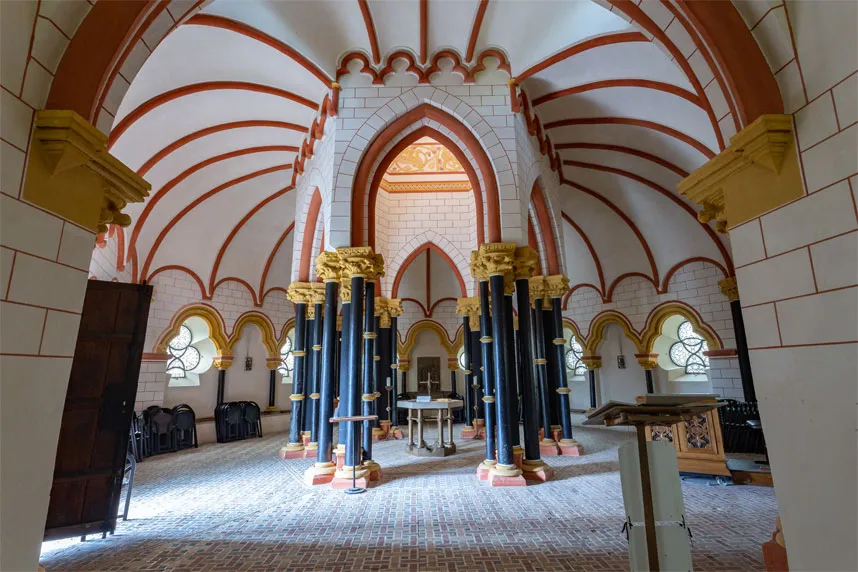
- St. Matthias Abbey Church overlooks a spacious plaza surrounded by attractive white buildings. The Romanesque church is plastered white and painted with orange accents.
- A Baroque facade has been added to the lower west front, which centers on a sculpture of St. Matthias holding an axe and an open book with a reference to John 15:14: “You are my friends if you do what I command.”
- The church has a “westwork” at the west end, with a tower of blind arcades and a gallery inside. There are two Romanesque towers at the east end. The Romanesque nave has square piers and simple round arches with no decoration, illuminated by small windows in the clerestory.
- This simplicity highlights the impressiveness of the ribbed vaulting, which continues into the westwork and the transepts. Painted roof bosses of bishops, angels and saints adorn each vault intersection – bring binoculars or a zoom lens for a good look. The side aisles have a simple Romanesque groin vault.
- The Tomb of the Apostle, with a barefooted marble effigy of Matthias, lies at the front of the nave surrounded by tall candles. The relics are beneath the tomb in a small, plain sarcophagus, which is accessible from the crypt.
- The crypt also contains two large sarcophagi labeled with Latin names. In the east end of the crypt, look for an interesting roof boss of a bishop defeating a demon.
- South of the church is the Benedictine Abbey of St. Matthias, with a 13th-century refectory and dormitory and 18th-century main building. Early Romanesque cloisters have been partly restored.
- The abbey museum displays a significant collection of artifacts, paintings and historical documents.
Buildings and art
The Romanesque St. Matthias’ Basilica, which was dedicated on 13 January 1148, combines four functions. It is the parish church of the parish of the same name; the monastic church of the Benedictine community; a pilgrimage church centred on the tomb of Saint Matthias the Apostle; and the burial church of the first bishops of Trier, Eucharius und Valerius. The church building, like all such, is in a constant state of tension between on the one hand the preservation and care of the structure, and on the other the need to meet current demands.
The basilica has therefore been thoroughly transformed during a long-drawn-out exercise in cleaning up and alteration. The crypt has been extended by a further two bays and provided with new means of access. The place of the veneration of Saint Matthias the Apostle, as well as the altar space, have been adapted to modern requirements. Stable choir stalls have been built for the monks’ choir. A lift has been installed for easier access to all levels. On 10 December 2007 during a solemn pontifical office with Bishop Reinhard Marx the bones of the Apostle Matthias in their shrine were translated to their final location in the crypt, with the solemn dedication of the altar planned for 24 February 2008. The conclusion of the building works with an overhaul of the electrics and a final paint job is not presently possible due to financial constraints. The Abbey church is considered a Marian shrine as it contains a Gnadenbild, an image of the Blessed Virgin that depicts the pregnant Mary, gazing in contemplation at the child she carries.
Reliquary of the Cross
In the Chapel of the Cross (Kreuzkapelle) in the north side-tower of the basilica is kept the reliquary of the cross, or “staurotheca”. It dates from the 13th century and is made of worked gold; in the centre is a golden cross set with precious stones, which is said to contain pieces of the True Cross. The Chapel of the Cross is accessible on guided tours.
Tomb of St. Matthias
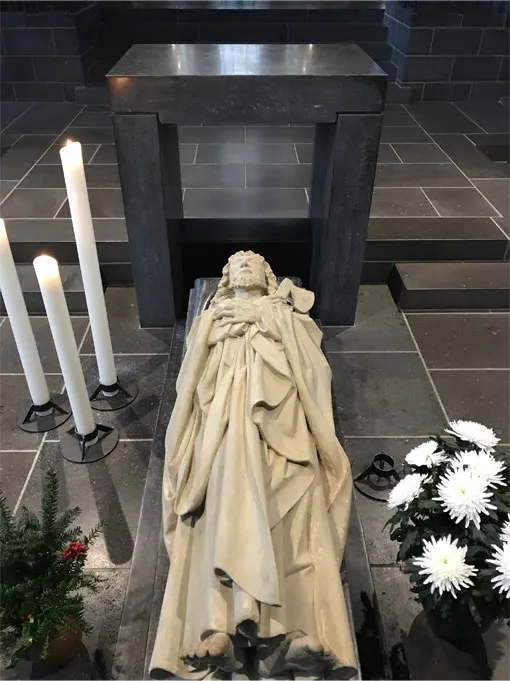
One of the most significant features inside St. Matthias’ Abbey is the tomb of St. Matthias, traditionally believed to house the remains of the Apostle Matthias. This tomb has been a destination for pilgrims throughout the centuries and remains a central focus within the abbey.
Mattheiser Venus
The Mattheiser Venus or Venus of St. Matthias was an ancient Roman marble statue of the goddess Venus, which was formerly kept at the St. Matthias’ Abbey. The statue of the goddess of love was kept on display in chains by the wall of the monastery marked with the following inscription:
„WOLT IHR WISSEN WAS ICH BIN
ICH BIN GEWESEN EIN ABGOTTIN
DA S. EVCHARIVS ZV TRIER KAM
ER MICH ZERBRACH MEIN EHR ABNAHM
ICH WAR GEEHRET ALS EIN GOTT
IETZ STEHEN ICH HIE DER WELT ZV SPOT.“
It was an established custom at the monastery to stone the statue annually to ritually celebrate the victory of Christianity over “Paganism” by annual desecration of the statue. This custom allegedly took place since the Middle Ages, but is confirmed since at least 1551. The statue was reduced to rubble, but the remains of it was transferred by the French commander of the town to a historical society in 1811. It is now kept at the Rheinisches Landesmuseum Trier.
Saint Matthias the Apostle
Matthias: He was a disciple of Jesus from his baptism by John until his Ascension. He replaced Judas Iscariot following Judas’ betrayal of Jesus and his subsequent hanging.
Outcome: Greek tradition holds that St. Matthias preached the Gospel around Cappadocia and along the Caspian Sea, living near the port of Issus. It is also said that he preached in Aethiopia (Modern-day Georgia) and Ethiopia. He was martyred by either stoning or beheading. His remains are buried in St Matthias Benedictine Abbey in Trier, Germany.
The Acts of the Apostles (1:15-26) tells us that Matthias was chosen after the resurrection to replace Judas. Peter, quoting a psalm, told the 120 people gathered that they must choose a new apostle: someone who had been with them from the time of the baptism of the Lord until the resurrection, someone who could join them in bearing witness to these events. Two names were put forward and the assembly casts lots, the lot falling to Matthias. Nothing more is known of his life or apostolic work.
According to one tradition, Saint Matthias preached for a time in Jerusalem and eventually he was stoned and beheaded. (He is often portrayed holding an axe, the instument of his death.) Another tradition claims he preached the Gospel to the barbarians and cannibals in the interior of Ethiopia and was crucified. Saint Matthias is the patron of carpenters, tailors, those with smallpox, and in prayers for perseverence and for hope.
The name of this saint is probably an abbreviation of Mattathias, meaning “gift of Yahweh”. Matthias was chosen to replace Judas Iscariot after Judas had betrayed Jesus and then committed suicide. In the time between Christ’s Ascension and Pentecost, the small band of disciples, numbering about 120, gathered together and Peter spoke of the necessity of selecting a twelfth apostle to replace Judas. Peter enunciated two criteria for the office of apostle: He must have been a follower of Jesus from the Baptism to the Ascension, and he must be a witness to the resurrected Lord. This meant that he had to be able to proclaim Jesus as Lord from first-hand personal experience. Two of the brothers were found to fulfill these qualifications: Matthias and Joseph called Barsabbas also called the Just. Matthias was chosen by lot. Neither of these two men is referred to by name in the four Gospels, although several early church witnesses, including Clement of Alexandria and Eusebius of Caesarea, report that Matthias was one of the seventy-two disciples.
Like the other apostles and disciples, St. Matthias received the gift of the Holy Spirit at Pentecost. Since he is not mentioned later in the New Testament, nothing else is known for certain about his activities. He is said to have preached in Judaea for some time and then traveled elsewhere. Various contradictory stories about his apostolate have existed since early in church history. The tradition held by the Greek Church is that he went to Cappadocia and the area near the Caspian Sea where he was crucified at Colchis. Some also say he went to Ethiopia before Cappadocia. Another tradition holds that he was stoned to death and then beheaded at Jerusalem. The Empress St Helena, mother of Constantine the Great, is said to have brought St Matthias’s relics to Rome c. 324, some of which were moved to the Benedictine Abbey of St Matthias, Trier, Germany, in the 11th century.
Death of Matthias
Matthias died in the year 80 AD. However, there is conflicting information about the place of death and burial site of Matthias. The Synopsis of Dorotheus tradition claims that Matthias died at Sebastopolis and was buried near the Temple of the Sun. Another tradition maintains that he was stoned in Jerusalem by the local people and beheaded. The Hippolytus of Rome tradition states that Matthias died of old age in Jerusalem. According to Nicephorus, a marker placed in the ruins of the Roman fortress at Gonio in the modern Georgian region of Adjara claims that Matthias is buried at that site. There is a claim that the remains of St. Matthias were taken to Italy by Empress Helena, the mother of Emperor Constantine the Great. The other part of these remains is said to have been taken to the Abbey of Santa Giustina in Padua, and the other part is in the Abbey of St. Matthias in Trier, Germany.
May 14 - Feast of Saint Matthias, Apostle
On May 14, we celebrate the feast of Saint Matthias. Saint Matthias was, according to the Acts of the Apostles, chosen by the apostles to replace Judas Iscariot following the latter’s betrayal of Jesus and his subsequent death. His calling as an apostle is unique, in that his appointment was not made personally by Jesus, who had already ascended into heaven, and it was also made before the descent of the Holy Spirit upon the early Church. The Acts of the Apostles state that Matthias was also one of the 72 disciples that the Lord Jesus sent out to preach the good news. Matthias was with the Lord since His Baptism, and was “a witness to Christ’s Resurrection,” according to St. Peter in Acts. He remained with Jesus until His Ascension.
According to various traditions, Matthias preached in Cappadocia, Jerusalem, the shores of the Caspian Sea (in modern day Turkey) and Ethiopia. He is said to have met his death by crucifixion in Colchis or by stoning in Jerusalem around AD 80. There is evidence cited in some of the early Church fathers that there was a Gospel according to Matthias in circulation, but it has since been lost, and was declared apocryphal by Pope Gelasius.
Veneration :
The feast of Saint Matthias was included in the Roman Calendar in the 11th century and celebrated on the sixth day to the Calends of March (24 February usually, but 25 February in leap years). In the revision of the General Roman Calendar in 1969, his feast was transferred to 14 May, so as not to celebrate it in Lent but instead in Eastertide close to the Solemnity of the Ascension, the event after which the Acts of the Apostles recounts that Matthias was selected to be ranked with the Twelve Apostles.
Relics :
It is claimed that St Matthias the Apostle’s remains were brought to Italy through Empress Helena, mother of Emperor Constantine I (the Great); part of these relics would be interred in the Abbey of Santa Giustina, Padua, and the remaining in the Abbey of St. Matthias, Trier, Germany. According to Greek sources, the remains of the apostle are buried in the castle of Gonio-Apsaros, Georgia.
Patron Saint :
St Matthias is invoked for assistance against alcoholism, and for support by recovered alcoholics.
St Matthias Abbey today
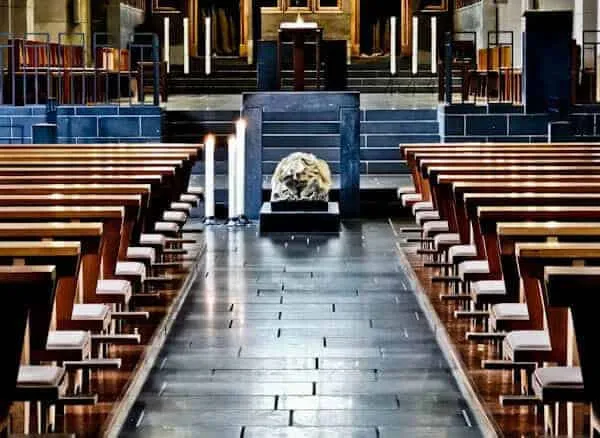
The abbey has been an important pilgrimage destination since the middle ages. Over 10,000 pilgrims come to the abbey each year to venerate the shrine of St. Matthias. Pilgrim-Shields are displayed on columns adjacent to the entrance to the Matthias-Crypt. Below the choir, visitors can view the impressive crypt, where numerous sarcophagi (including the two sarcophagi of the first bishops of Trier, Valerius and Eucharius) are kept. The abbey museum displays a significant collection of artefacts, paintings and historical documents.
Annual Feast Day
Feast day: 14 May
The feast day of Saint Matthias is celebrated on May 14th in the Roman Catholic Church and on February 24th (February 25th in leap years) in the Eastern Orthodox Church and some Protestant denominations.
Church Opening Time
Monday to Friday: 2 p.m. – 5.45 p.m.
Saturday: 9.30 a.m. – 12 p.m.
Sunday: 11 a.m. – 12.45 p.m.
Mass Timing
Sunday:
07.00 a.m. Lauds
10.00 a.m. Conventual Mass
6.00 p.m. Vespers
Monday – Friday:
5.45 a.m. Matins and Lauds (Wednesday: Silent prayer and Lauds)
12.30 p.m. Midday prayer | 6.15 p.m. Vespers (Thursdays and feast days combined with the Eucharist)
8 p.m. Compline (Thursday: 9 p.m.)
Saturday:
07.30 am Lauds | 12.30 pm Midday Prayer
18.15 pm Vespers | 20.00 pm Vigil
Contact Info
St. Matthias’ Abbey
Matthiasstraße 85,
54290 Trier,
Germany.
Phone No.
Tel :+49 651 17090
Accommodations
Connectivities
Airway
The nearest airport to The Church of St. Matthias’ Abbey Trier, Germany is, Luxembourg Airport (LUX), Rue de Trèves, 1110, Luxembourg, which is just 36 min (41.8 km) via A1 away from the basilica.
Railway
The nearest railway to The Church of St. Matthias’ Abbey Trier, Germany, BTL Université de Luxembourg, 1 Bd du Jazz, 4370 Esch-sur-Alzette, Luxembourg, which is just 53 min (71.5 km) via A1 away from the basilica.


